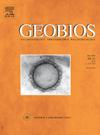First palynological record from Corcovado, central Patagonia, Argentina: Evidence for an age between the late Eocene and the Miocene
IF 1.6
4区 地球科学
Q2 PALEONTOLOGY
引用次数: 0
Abstract
We present the first palynological record from the Corcovado locality in Chubut, central Patagonia, Argentina. The analyzed stratigraphic section, tentatively attributed to the Huitrera Formation, yielded a single productive horizon containing spores, pollen grains, and fungal remains, despite generally poor preservation. A total of 38 species were identified, comprising 22 angiosperms, 2 gymnosperms, 9 pteridophytes, and 5 distinct fungal morphotypes. The Nothofagaceae family is notably dominant, accounting for approximately 50% of the identified palynoflora, with no warm-climate adapted taxa recorded. Ordination analyses suggest that the studied assemblage reflects terrestrial environments consistent with other Cenozoic deposits in Patagonia; however, it lacks sufficient resolution for precise age determination, suggesting a late Eocene or younger age. Its stratigraphic position, underlying the Miocene Ñorquinco/Ñirihuau Formation, constrains its minimum age, suggesting a late Eocene to Miocene age interval for the analyzed section. The study contributes to the understanding of the paleoenvironmental and paleoclimatic conditions of the region, revealing vegetation patterns typical of terrestrial ecosystems. Furthermore, it addresses a significant gap in paleobotanical research in central Patagonia, an area that has been comparatively underexplored relative to other parts of the region.
阿根廷巴塔哥尼亚中部Corcovado的第一个孢粉记录:始新世晚期和中新世之间的证据
我们提出了阿根廷中部巴塔哥尼亚Chubut的Corcovado地区的第一个孢粉记录。经过分析的地层剖面,暂定为Huitrera组,发现了一个含有孢子、花粉粒和真菌遗骸的单一生产层,尽管保存得很差。共鉴定出38种,其中被子植物22种,裸子植物2种,蕨类植物9种,真菌形态5种。孢粉菌科(Nothofagaceae)在孢粉菌群中占有显著优势,约占已鉴定孢粉菌群的50%,未发现适应温暖气候的分类群。排序分析表明,所研究的组合反映了与巴塔哥尼亚其他新生代矿床一致的陆相环境;然而,它缺乏足够的分辨率来精确测定年龄,表明它的年龄在始新世晚期或更年轻。其地层位置位于中新世Ñorquinco/Ñirihuau组之下,限制了其最小年龄,表明所分析剖面的年龄区间为晚始新世至中新世。该研究有助于了解该地区的古环境和古气候条件,揭示典型的陆地生态系统植被格局。此外,它还解决了巴塔哥尼亚中部古植物学研究的重大空白,该地区相对于该地区的其他地区勘探相对不足。
本文章由计算机程序翻译,如有差异,请以英文原文为准。
求助全文
约1分钟内获得全文
求助全文
来源期刊

Geobios
地学-古生物学
CiteScore
3.30
自引率
6.20%
发文量
28
审稿时长
6-12 weeks
期刊介绍:
Geobios publishes bimonthly in English original peer-reviewed articles of international interest in any area of paleontology, paleobiology, paleoecology, paleobiogeography, (bio)stratigraphy and biogeochemistry. All taxonomic groups are treated, including microfossils, invertebrates, plants, vertebrates and ichnofossils.
Geobios welcomes descriptive papers based on original material (e.g. large Systematic Paleontology works), as well as more analytically and/or methodologically oriented papers, provided they offer strong and significant biochronological/biostratigraphical, paleobiogeographical, paleobiological and/or phylogenetic new insights and perspectices. A high priority level is given to synchronic and/or diachronic studies based on multi- or inter-disciplinary approaches mixing various fields of Earth and Life Sciences. Works based on extant data are also considered, provided they offer significant insights into geological-time studies.
 求助内容:
求助内容: 应助结果提醒方式:
应助结果提醒方式:


